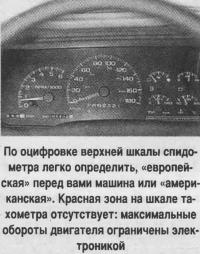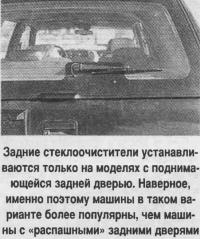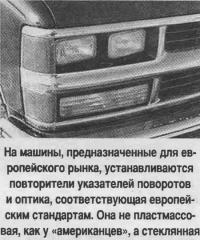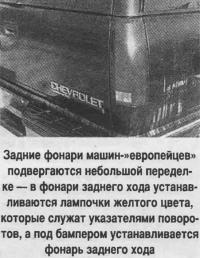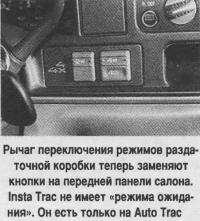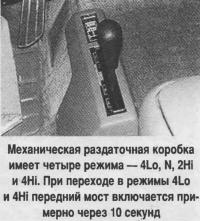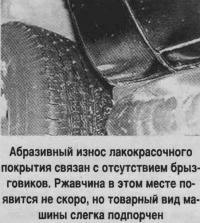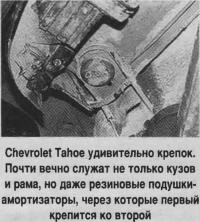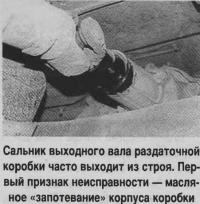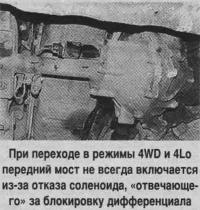And who are you tahoy?
The car, known to us under the name Chevrolet Tahoe, appeared in America in 1964 as the GMC Yukon and was produced only for the American market. In 1980 «was born» its twin, the Chevrolet Tahoe, was supplied to both the domestic and European markets. Since 1990, the body of the Tahoe has hardly changed, except for the improvements that occurred in 1995 in the design of the interior, headlights and radiator grille.
Understanding the modifications is very easy. Tahoe is available in three-door and five-door body styles. There is also a sports modification of the three-door body (Sport), on which wheel arch extensions and plastic panels are installed on the lower part of the doors and sills (ordinary bodies are decorated only with moldings). In 1997, a five-door seven-seat modification with two additional seats was produced.
There are even fewer types of engines than bodies. Until 1996, all models were equipped with a TBI petrol engine with central injection, with a capacity of 210 hp, and since 1996 - a 5.7-liter Vortec with multipoint injection, the power of which was increased to 254 hp. True, this was due not to an actual increase in power, but to a change in the maximum engine speed limit from 4000 rpm. up to 5500 rpm As a result, the engine torque has increased.
Diesel engine of 6.2 liters. in 1995 it was replaced by a 6.5-liter turbodiesel, which became more resourceful, but its torque was slightly reduced.
Regardless of the type of body and engine, all cars are available with both rear and all-wheel drive. To transmit the torque developed by the engine, the vehicle has...
Tahaya transmission
Transmission, as in all «Americans», automatic. A five-speed manual gearbox is installed only on request.
There are three types of transfer cases: manual, Insta Tgas and the latest fashion R electronic Auto Tgas. The mechanical transfer case, which was installed on all cars from the very beginning of the production of all-wheel drive modifications, had four operating modes: 2Hi P rear-wheel drive; 4 Hi P all-wheel drive; 4 Lo - four-wheel drive with downshift and N - «neutral». Insta Tgas, which replaced it, has the same modes. True, the mode switch knob, located on the floor in a mechanical transfer case, was replaced with switches on the instrument panel. In 1997, the Auto Tgas box appeared. In addition to all the listed modes, it has a standby mode. When the 4WD mode is on, the four-wheel drive is turned on only when it is needed.
Regardless of body type, engine and transmission, vehicles may or may not be equipped with rear axles with self-locking differentials. The front drive axles cannot but have a differential lock. The design feature of Tahoe is such that the front-wheel drive is engaged only after the front differential is locked...
Tah, tah, tah...
This issue requires special attention. Tahoe does not have a center differential at all, but a separate conversation is about the center differential.
With the back, everything is simple - either it is not there, or it is self-locking and turns on at its own discretion. Front differential (naturally, in the presence of a front drive axle) is always there and is forced. When you want to switch to 4WD or 4Lo mode, first of all by means of a thermal type solenoid which is installed in the front axle (and often fails), the differential is locked. Only after that the front axle becomes the leading one,
It follows from the above that when driving on a dry road in 4WD mode at high speed, you MUST «tear up» either the front axle, or both the front axle and the transfer case. This is probably why General Motors came up with the Auto Tgas transfer case, which saves you from these troubles and the associated costs.
Since we've looked under the car, let's take a closer look...
Tah what's down there?
From below, everything is simple and extremely reliable: frame, rear - springs (which, however, some dashing riders manage to break), in front - a double-lever torsion bar suspension, the endurance of which causes the burning envy of competitors. Agree, this is very reminiscent of a truck device. The car is exceptionally soft and smooth on the go. Like many American SUVs, it has a slight lateral swaying of the body. True, neither the driver nor the passengers experience much discomfort. If you remember to service your car regularly, there will be no problems with it. The only relatively weak point is the steering. The pendulum arm, bipod and rod ends periodically require replacement. All other troubles can only be associated with a particularly aggressive driving style and collisions with obstacles - curbs, wells, etc. If you don’t mock Tahoe for how much in vain, then they will be able to drive it painlessly «with the wind» and your grandchildren.
From below, everything is simple and extremely reliable: frame, rear - springs (which, however, some dashing riders manage to break), in front - a double-lever torsion bar suspension, the endurance of which causes the burning envy of competitors. Agree, this is very reminiscent of a truck device. The car is exceptionally soft and smooth on the go. Like many American SUVs, it has a slight lateral swaying of the body. True, neither the driver nor the passengers experience much discomfort. If you remember to service your car regularly, there will be no problems with it. The only relatively weak point is the steering. The pendulum arm, bipod and rod ends periodically require replacement. All other troubles can only be associated with a particularly aggressive driving style and collisions with obstacles - curbs, wells, etc. If you don’t mock Tahoe for how much in vain, then they will be able to drive it painlessly «with the wind» and your grandchildren.
Examination
The transfer box rear shank oil seal often leaks. The first sign of its failure is oil «fogging» shank body. When replacing the oil seal, replace the bronze bushing that acts as the support bearing for the transfer case output shaft.
The Chevrolet Tahoe has a leaking rear axle gear shank seals. The axle shaft seals also leak, but less often.
Another fairly common Tahoe malfunction is the failure of the driveshaft crosses.
The Chevrolet Tahoe's suspension is exceptionally reliable. There are practically no cases when replacement of ball bearings is required. Relatively weak points of the suspension are the pivot joints of the pendulum arm and the steering arm, as well as the steering rod joints.
Tahoe Suspension Pivots (ball joints, tie rods) lubricate through oilers («squirt»). It is best to use Mobil HP222 grease. The number of lubrication points is 11, the recommended interval is 5000 km. Even with lubrication after 10,000 km, there are no signs of suspension wear.
Sometimes when you turn on the 4WD mode, the front-wheel drive does not turn on. This is due to the frequent failure of the front differential lock solenoid.
The Tahoe does not come standard with wheel mudguards, resulting in abrasion to the paintwork at the rear bottom of the front and rear fenders. Rust was not noticed in these places, but it is better to install mudguards to preserve the appearance.
The Chevrolet Tahoe is available with 16" and 17" wheels. If your car had 16" wheels and you changed them to 17" (and vice versa), you need to reprogram your computer. Otherwise, the correct operation of the speedometer and the ABS system cannot be guaranteed.
If any electrical sensors fail, look for rotten or frayed wires. Problems, most likely, are connected with them. The sensors themselves and the wire connections are quite reliable.
Special calipers are installed on the brake pads («tweeters»). They scrape the brake discs and make a squeaking sound, signaling pad wear. This sound is only heard when driving, not when braking, so often car owners do not associate it with the braking system. This leads to complete abrasion of the lining and severe wear of the brake discs. Discs will need to be replaced! Having raised the car on a lift, you need to shake the left CV joint. A large play on the right side indicates that the CV joint bearing has become loose. This indicates that the previous owner frequently used 4WD when driving at high speeds on dry roads. As you know, such operation leads to transmission failure. Serious problems and big expenses await you! Chronic «disease» Chevrolet Tahoe, like most cars manufactured by General Motors, has a frequent failure of the generator bearings and the relay-regulator.
On gasoline engines 5.7 liters. valve oil seals wear out. This results in increased oil consumption as well as «brining» and subsequent failure of the exhaust gas catalytic converter.
Short
If you frequently drive in the mountains, tow a trailer, make short trips with an engine that is not fully warmed up, or simply operate your car in an urban environment, your Tahoe is recommended «heavy» service (halved against normal intervals): oil change in the gearbox - every 25,000 km, in the transfer case - every 50,000 km.
Instead of the usual antifreeze (replacement - every 50,000 km or two years of operation) into the Tahoe cooling system is better once every five years (or every 160,000 km) fill with Dexcool liquid.
By reducing engine oil change intervals to 5000 km, as recommended by General Motors, the engine can last indefinitely. The only thing that may be required is the replacement of valve oil seals. When using Mobil 1 5W/30 Fully Synthetic oil, this interval can be extended to 10,000 km.
If you follow the maintenance schedule, regularly change oils and filters, cars with a mileage of 300,000 km do not show signs of wear.
Constant driving on a dry road in 4WD mode will lead to failure of the transfer case and front axle, and in 4Lo mode it will also damage the rear axle.
In a manual transmission, use ONLY GM Good Wrench oil. There is no substitute for this oil!
Tahoe axles should be filled with 80W/90 GL5 oil or equivalent.
With special hardware and software, the Tahoe computer can be reprogrammed (e.g. for leaded petrol). For our operating conditions, reprogramming to the so-called «unleaded export». In this case, the computer takes into account the readings of the oxygen sensors (there are four on the latest Tahoe models), but the content of harmful emissions is not as strict as in «Californian» or «American» options.
When replacing the steering knuckle, the ABS sensor must also be replaced - most likely, it will not be possible to remove the sensor from the old knuckle.
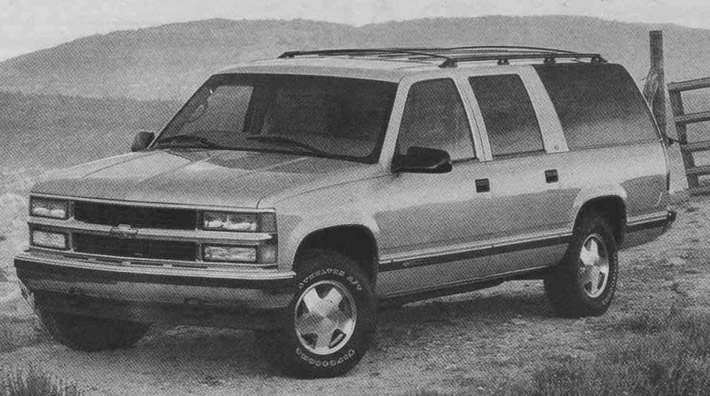
Шевроле Тахо 1998 K1500 4x4 Suburban

